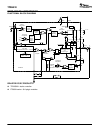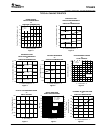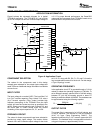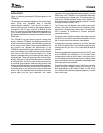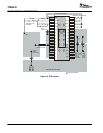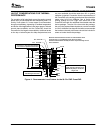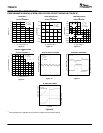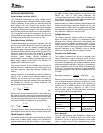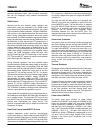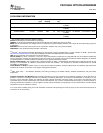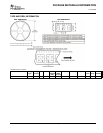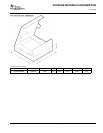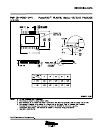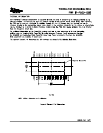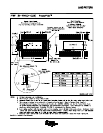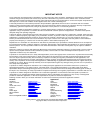
TPS54810
SLVS420B − MARCH 2002 − R EVISED FEBRUARY 2005
www.ti.com
14
particular application needs. Type 2 or type 3 compensa-
tion can be employed using external compensation
components.
PWM Control
Signals from the error amplifier output, oscillator, and
current limit circuit are processed by the PWM control
logic. Referring to the internal block diagram, the control
logic includes the PWM comparator, OR gate, PWM latch,
and portions of the adaptive dead-time and control logic
block. During steady-state operation below the current
limit threshold, the PWM comparator output and oscillator
pulse train alternately reset and set the PWM latch. Once
the PWM latch is reset, the low-side FET remains on for a
minimum duration set by the oscillator pulse width. During
this period, the PWM ramp discharges rapidly to its valley
voltage. When the ramp begins to charge back up, the
low-side FET turns off and high-side FET turns on. As the
PWM ramp voltage exceeds the error amplifier output
voltage, the PWM comparator resets the latch, thus
turning off the high-side FET and turning on the low-side
FET. The low-side FET remains on until the next oscillator
pulse discharges the PWM ramp.
During transient conditions, the error amplifier output
could be below the PWM ramp valley voltage or above the
PWM peak voltage. If the error amplifier is high, the PWM
latch is never reset and the high-side FET remains on until
the oscillator pulse signals the control logic to turn the
high-side FET off and the low-side FET on. The device
operates at its maximum duty cycle until the output voltage
rises to the regulation set-point, setting VSENSE to
approximately the same voltage as VREF. If the error
amplifier output is low, the PWM latch is continually reset
and the high-side FET does not turn on. The low-side FET
remains on until the VSENSE voltage decreases to a
range that allows the PWM comparator to change states.
The TPS54810 is capable of sinking current continuously
until the output reaches the regulation set-point.
If the current limit comparator trips for longer than 100 ns,
the PWM latch resets before the PWM ramp exceeds the
error amplifier output. The high-side FET turns off and
low-side FET turns on to decrease the energy in the output
inductor and consequently the output current. This
process is repeated each cycle in which the current limit
comparator is tripped.
Dead-Time Control and MOSFET Drivers
Adaptive dead-time control prevents shoot-through
current from flowing in both N-channel power MOSFETs
during the switching transitions by actively controlling the
turnon times of the MOSFET drivers. The high-side driver
does not turn on until the voltage at the gate of the low-side
FET is below 2 V. While the low-side driver does not turn
on until the voltage at the gate of the high-side MOSFET
is below 2 V.
The high-side and low-side drivers are designed with
300-mA source and sink capability to quickly drive the
power MOSFETs gates. The low-side driver is supplied
from VIN, while the high-side drive is supplied from the
BOOT pin. A bootstrap circuit uses an external BOOT
capacitor and an internal 2.5-Ω bootstrap switch
connected between the VIN and BOOT pins. The
integrated bootstrap switch improves drive efficiency and
reduces external component count.
Overcurrent Protection
The cycle by cycle current limiting is achieved by sensing
the current flowing through the high-side MOSFET and
comparing this signal to a preset overcurrent threshold.
The high side MOSFET is turned off within 200 ns of
reaching the current limit threshold. A 100 ns leading edge
blanking circuit prevents false tripping of the current limit
when the high side switch is turning on. Current limit
detection occurs only when current flows from VIN to PH
when sourcing current to the output filter. Load protection
during current sink operation is provided by thermal
shutdown.
Thermal Shutdown
The device uses the thermal shutdown to turn off the power
MOSFETs and disable the controller if the junction
temperature exceeds 150°C. The device is released from
shutdown automatically when the junction temperature
decreases to 10°C below the thermal shutdown trip point,
and starts up under control of the slow-start circuit.
Thermal shutdown provides protection when an overload
condition is sustained for several milliseconds. With a
persistent fault condition, the device cycles continuously;
starting up by control of the soft-start circuit, heating up due
to the fault condition, and then shutting down upon
reaching the thermal shutdown trip point. This sequence
repeats until the fault condition is removed.
Power Good (PWRGD)
The power good circuit monitors for under voltage
conditions on VSENSE. If the voltage on VSENSE is 10%
below the reference voltage, the open-drain PWRGD
output is pulled low. PWRGD is also pulled low if VIN is
less than the UVLO threshold or SS/ENA is low. When
VIN ≥ UVLO threshold, SS/ENA ≥ enable threshold, and
VSENSE > 90% of V
ref
, the open drain output of the
PWRGD pin is high. A hysteresis voltage equal to 3% of
V
ref
and a 35 µs falling edge deglitch circuit prevent
tripping of the power good comparator due to high
frequency noise.



